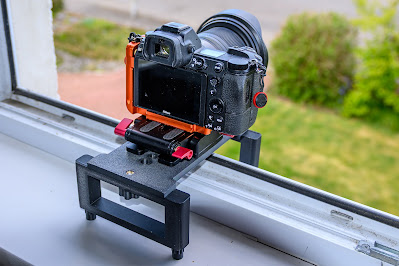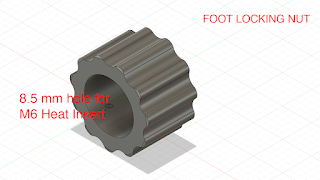 |
| The three 3d-printed plates to fit Peak Design's Capture Clip with ProPad One of the top plates is used , depending on the width of the belt The bottom plate is optional |
This article needs an introductory word on differences between English English and American English on items of gentlemen’s clothing. Trousers in UK are items of outerwear. In the USA they are ‘pants’. Pants in UK by contrast are items of underwear. In UK ‘shorts’ may be pouter or underwear, usually these days usually the former.
The Peak Design Capture Clip with Pro Pad attachment is designed to fasten to your trouser belt such that the camera hangs in space from the quick-release plate bolted to the tripod bush. Peak Design show this arrangement working in their promotional material. However, when I tried this with a moderately heavy camera and long lens I was left in fear and dread of the weight pulling down both belt and trousers to my ankles. While not overly concerned about such a wardrobe malfunction I did worry that the first thing to hit the ground would be the front of the lens. Both my grandfathers would have pointed out that a good pair of braces would have provided all the security needed; they were both ‘belt and braces’ men. However, braces went out of fashion in the 1950s but I do notice while people watching that they are far more commonly worn in the USA than in UK, so Peak Design’s arrangement may give less course for concern in the country of their design. Using a second belt around the waist for the Capture Clip/Pro Pad would eliminate the trouser problem altogether.
I then realised that if some of the weight of the camera could be borne by a shoulder strap then trousers and camera would not only be safe but also more comfortable to carry. Those who know their military history will realise we are now in Sam Browne territory.
General Sir Samuel Browne VC had his left arm severed at the shoulder by a sword in an action during the Indian Mutiny in 1858. It was his bravery that day resulted in the award of the Victoria Cross. Lacking his left arm he had difficulty in returning his sword to its scabbard. In order to stabilise the sword belt he had attached to the belt a strap that passed diagonally over the right shoulder. Other officers in the Indian Army realised that the Sam Browne Belt was useful even to possessors of two arms and its use eventually spread into the British Army and then to forces, civil as well as military, around the world. The Sam Browne must have conveyed some sense of power and seniority as well as utility since it still plays that role in fact and fiction. Commissioner Selwyn Patterson in the BBC detective series Death in Paradise is incomplete without his Sam Browne.
 |
| Sam Browne Belt Creative Commons CCO 1.0 Universal Public Domain Dedication |
Those who know their camera accessories will realise that a ready-made Sam Browne camera belt is made by Cotton Carriers in the form of their Slingbelt. That though seems to lack a quick-release plate suitable for rapid attachment to a tripod or monopod.
The system I have devised using simple 3D-printed parts allows a Peak Design Camera Strap (Slide or Slide-Lite) to play the part of the diagonal over-the-shoulder strap of the Sam Browne.
 |
| Capture Clip and Pro Pad converted to Same Browne arrangement. The camera strap in the upper part of the photograph passes over the opposite shoulder |
 |
| Optional plate added - enables faster location of the entrance to the Capture Clip |
A simple plate inserted during assembly of the Capture Clip/Pro Pad has two holes to which can be attached Peak Design Anchor Connectors. That alone may be sufficient for some users but if another plate is also added, a ‘landing pad’ for the quick-release plate above the slide-in entry on the clip, the process of inserting the camera into the clip is quicker and easier. The photographs show how the system works and extends the use of the Capture Clip.
Stages of Assembly
How to Build Your Own
You can download stl files from Google Drive HERE
I used a Bambu Labs A1 3D-printer with the following settings: Smooth Plate; Bambu PLA Matte Filament; 0.4 Hot End; Preset 0.2 mm Strength plus the 25% sparse infill with gyroid pattern.
















































